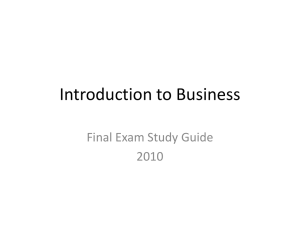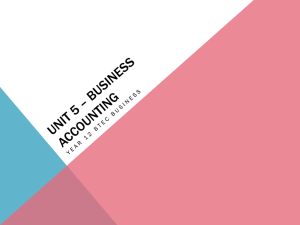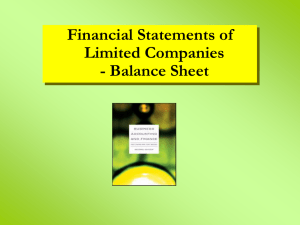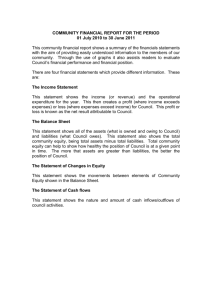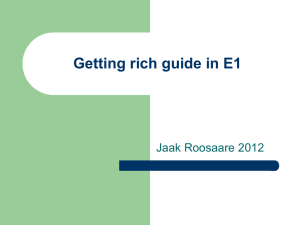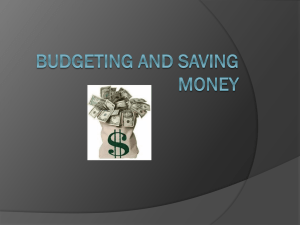Company Accounts *
advertisement
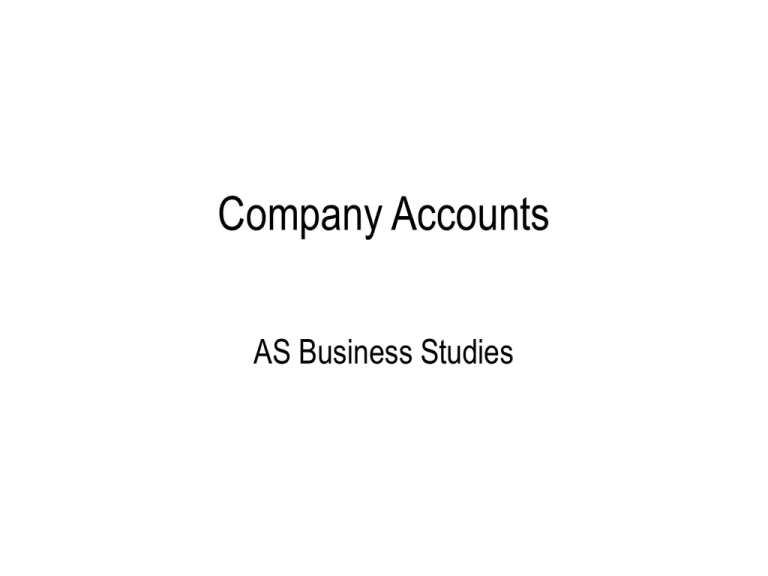
Company Accounts AS Business Studies Content • • • • • • Capital and revenue expenditure Cash flow forecasting Improving cash flow Control of working capital Cash flow vs. profit Sources of finance: – Internal – External • • • • Profit and loss Balance Sheets Depreciation Window dressing Capital and Revenue Expenditure • Capital expenditure – spending on items that can be used time and time again in the production process (fixed assets) • Revenue expenditure – meets current day-to-day expenses e.g purchase of raw materials and the payment of wages Cash Flow Forecast & Cash Flow Statements • A Forecast is a prediction of what may happen in the future • A cash Flow Forecast is therefore a prediction of the inflows and outflows of cash in the future • Businesses use past figures and experiences to predict forecasts • A Cash Flow statement differs from a forecast. It detailed what has happened in the business, i.e. the money that has flowed in and out of the business Cash Flow Forecast • Opening balance • Total incomes – Sale of goods – Rental income • Total expenditures – – – – Materials Energy costs Wages Transport Cash Flow Forecast cont… • Total incomes – total expenditures (outflows) = net cash flow • Opening balance + net cash flow = Closing balance • Closing balance is then carried forward as the opening balance for the next month Uses of cash flow forecasts • To anticipate potential shortages of cash • To examine and possibly adjust the timings of receipts and payments, in order to avoid problems • To arrange financial support where problems are forecast Problems with cash flow • • • • • Inaccurate market research Changing tastes Competitors Economic changes Uncertainty Cause of cash flow problems • • • • • • Seasonal demand Overtrading Over-investment in fixed assets Credit sales Poor stock management Unforeseen change Types of cash flow problems • • • • • Long term structural problems Cyclical features Internal problems / inefficiencies External changes Working capital problems Ways of improving cash flow • • • • • • Improve planning More thorough market research Diversifying the product portfolio Improved decision making Contingency funds Use of sources of finance to avoid short term working capital problems Cash flow vs. profit • Cash flow is most important in the short term as it is the businesses ability to pay their bills • Profit is more important in the long term • Businesses can be profitable and still experience cash flow problems Working Capital • Working capital measures the amount of money the business has to pay day-to-day expenses • Working capital = current assets – current liabilities • Businesses need to be aware of their working capital and ensure that they have enough cash to survive Control of working capital • Stock and debtor control – arranging appropriate credit terms • Liquidity – need to manage assets to ensure that the business has sufficient liquidity (ease of converting assets to cash) • Stock needs to be valued correctly • Need to ensure are not holding excess stocks or excess cash Sources of Finance • These are how businesses get money to finance growth, to overcome working capital / cash flow problems etc • Internal sources – from inside the business • External sources – from outside the business • Internal sources: – No external body to pay – Generally no time limit Internal Sources - Retained Profit • Cheap and flexible • Technically profit is shareholders so they need convincing its used effectively • Usually okay infrequently • Idea retained profit used to generate future profits and therefore used for purchase of fixed assets • Opportunity cost needs to be assessed Internal Sources - Sale of Assets • This can allow business to develop more profitable ventures • If in crisis can sell fixed assets but will lead to a decrease in profitability in long term • In principle the sale of these assets should allow a firm to increase its level of profit Internal Sources - Sale and Leaseback • This allows the organisation to receive a cash payment – improving short term cash flow • But have to rent the asset which may reduce profit long term • If cash used to buy more profitable assets the cost of rental is covered External sources of finance – long term – Share Capital • • • • Share capital Limited companies can issue shares Share holders receive dividends Shares can be – Preference shares – fixed % dividend – Ordinary shares – risk capital / equity Loan capital • Providers of loans = creditors • Four main types of loan capital: – Debentures – long term loan to the business at an agreed fixed % of interest repayable on a stated date. Up to 25 years. – Mortgages – used to purchase property. Up to 25 years – Long term loans – provided by specialist organisations – Government assistance – selective and takes form of grants generally External sources of finance – medium term • Bank loans • Leasing • Hire purchase External sources of finance – short term • Bank overdrafts – agreed limit, stated time period • Trade credit – suppliers allow time period before money is due • Debt factoring – business receives immediate payment for credit sales Sources of Finance - Choice • Businesses need to consider a number of factors when deciding what sources of finance to use • External sources of finance are more expensive as you need to pay interest • To use retained profits you need to get agreement from shareholders • The source of finance chosen also depends on the time period and what you need the finance for Profit and Loss Account • This is a financial statement that shows a businesses revenues, expenses and profit / loss over a period of time • Gross profit = Sales – cost of sales • Net profit = Gross profit – overheads • Retained profit = Net profit – tax – dividends • Trading account – shows the income earned by the business over a trading period • Appropriation account – the uses of net profit after taxation Interpreting Profit and Loss Accounts • The following groups are interested in a businesses profit and loss accounts: – – – – Shareholders Managers Employees Inland revenue / government Balance Sheets • Balance sheets are financial statements that record the assets and liabilities of a business at a specific point in time • Assets – items owned by a business • Fixed assets – items owned by a business expected to be retained for at least one year e.g. buildings • Current assets – items that are expected to be turned into cash in the next year e.g. cash, stock • Liabilities – monies owed by a business • Current liabilities – debts owed by the business payable within a year e.g. creditors • Long term liabilities – debts owed by the business which wont be repaid within the next year e.g. bank loan Balance Sheets - Rules 1. Assets = Liabilities 2. Total Assets = Fixed assets + current assets 3. Liabilities = Share capital + borrowings + other creditors + reserves Depreciation • The decrease in value of assets over time • This is shown as an expense on the profit and loss account • Fixed assets will be depreciated in value on the balance sheet • Two methods: – Straight line – Reducing Window dressing • These improve the appearance of a companies balance sheet • Can borrow money for a short period of time to improve cash position just before date of balance sheet • Use sale and leaseback • Include intangible assets e.g. goodwill / brands on balance sheet • Capitalise expenditure – including things as assets that could be classified as expenses Summary • • • • • • Capital and revenue expenditure – capital spend on fixed assets, revenue on day to day expenses Cash flow forecasting – a prediction of cash inflows – cash outflows Improving cash flow – cash flow can be improved by better planning, sources of finance, revision of credit terms and better market research Working capital – current assets – current liabilities, need to ensure have sufficient cash to operate Cash flow vs. profit – Cash flow - short term and profit long term Sources of finance – these are ways businesses can get money – Internal – from inside the business e.g. retained profits, sale of assets – External – from outside the business e.g. loans, mortgages • • • • Profit and loss – shows revenues, expenses and profit / loss over a period of time Balance Sheets – record assets and liabilities on a specific day Depreciation – the reduction in value of fixed assets over time Window dressing – techniques used to improve appearance of accounts


